Click Here To Join Our Telegram Channel for FREE daily tutorials!
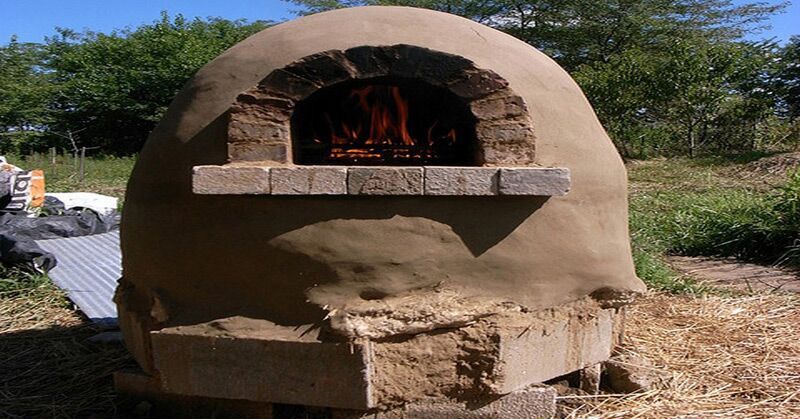
I must admit, I’m a bit of a breadhead. Few things are as exciting to me as freshly baked bread with a dab of butter, or hot and greasy scallion pancakes, or fluffy and airy naan, or a pizza fresh from the hearth of a wood-fired oven. (That last one trumps all the others.) I thrive on bread. I love eating it, and of course, I love making and baking it, too.
Earlier in the year, the idea of baking in the outdoors in a wood-fired oven became something of a romanticized (in every positive sense of the word) notion to me. It was soon obvious that I should build a cob oven, which would be fairly easy and quick to build, and quite cheap, too. Compared to masonry ovens, which can cost hundreds or thousands of dollars and usually require cement in their construction (which I am pretty opposed to on all fronts), a cob oven can be made from very simple, locally available materials. (Although it must be said that masonry ovens undoubtedly have a longer lifetime!)
So I picked up a copy of Kiko Denzer’s Build Your Own Earth Oven, a little gem of a book covering the construction of cob ovens from the ground up. And in July, after I settled into my new house, I knew it was time to start building this oven I had been dreaming about, so I could finally make pizza the way it was meant to be baked: on a super hot brick hearth.
How To Build An Outdoor Pizza Oven
The Foundation
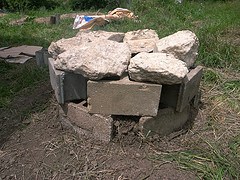 With little more than some clay, sand, sawdust, brick, some recycled beer bottles and old cinder blocks, I had everything I needed to make my own oven. After familiarizing myself with Kiko’s design, I began building the foundation for my version from the reclaimed cinder blocks and a few chunks of an urbanite. A foundation raises the oven off of the ground and places it at a more convenient working height. (A hearth 40″ off the ground is a good average working height.)
With little more than some clay, sand, sawdust, brick, some recycled beer bottles and old cinder blocks, I had everything I needed to make my own oven. After familiarizing myself with Kiko’s design, I began building the foundation for my version from the reclaimed cinder blocks and a few chunks of an urbanite. A foundation raises the oven off of the ground and places it at a more convenient working height. (A hearth 40″ off the ground is a good average working height.)
The Fire Brick Oven Hearth
An insulating layer of beer bottles in a sawdust/clay mortar was assembled on top of the foundation in a ring of cob and beneath the firebrick hearth. The hearth, a simple arrangement of 17 recycled firebricks, would serve as the bottom of the cob oven, where bread and pizzas would bake directly. The hearth bricks were carefully laid on a thin bed of sand so that they could be gently tapped to be firm and level.
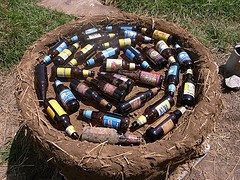
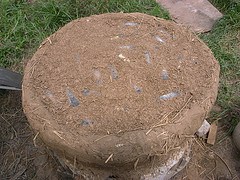
(Laying out the beer bottles, and later, filling in with sawdust/clay mortar)
Sizing the Cob Oven
I chose to construct a 22.5″ diameter oven, deciding that anything bigger would be beyond my current needs, and after using it, it’s definitely proven to be the perfect size. You can fit three medium-sized loaves of bread, or one or two small personal-sized pizzas in it at once. And at this small size, the entire mass can be heated to about 700 degrees in two hours of solid firing with good wood.
Making a Brick Arch Doorway and Cob Dome
Before building the actual dome, I made an arched doorway with some reclaimed red brick, mortared with a sand/clay mix. (The doorway is a little narrow at 12 inches wide, but so far everything I’ve wanted to fit has slid right in. And it can’t make really big pizzas, but I’m liking the smaller sized pies.) The cob dome (nothing more than a mix of sand and clay at a 3:1 ratio) was carefully built up around a moist sand form covered with wet newspaper and up against the brick arch. The sand was piled out of the doorway after the dome had dried a bit.
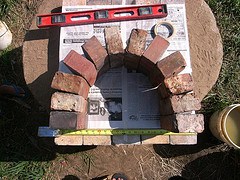
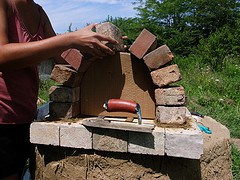
(Tracing the brick arch to make a cardboard form, setting the bricks on the cardboard form)
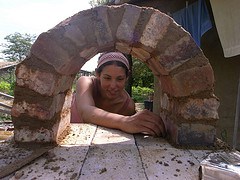
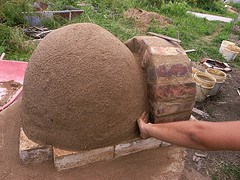
(Finishing touches on the clay/sand mortar between bricks, then making a smooth sand form)

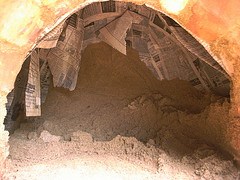
(Four inches of cob go up around the sand form, and later, the sand is dug out out the dome [interior view])
One more note about the door: the door is a critical 63% of the cob dome height or 10″ high. (The dome is 16″ high, which is Kiko’s recommendation for cob ovens across the board.) This one measurement is the most critical because it allows the oven to actually draw. You see, the door is left open while the oven is firing, so that cool air is drawn in, and hot air and smoke can pass out the top half of the door. (Larger ovens frequently have a chimney, or you can make a simple firing door to help with draw, too.)
Cob Dome Insulation and Plaster
A several inches thick (between 2″-4″) layer of insulation (a mix of sawdust and clay slip) went over the whole dome. This layer helps to keep the heat longer, allowing for longer heat and longer bakes. Cob ovens built strictly for pizza don’t require such a layer, and more serious bread bakers may want to double up on insulation thickness since it will allow for the baking of many loaves. Finally, a thick layer of earthen plaster covers and protects the whole thing.
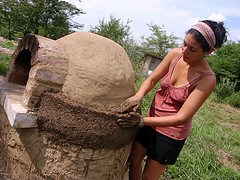
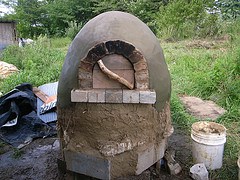
(2-4 inches of sawdust/clay insulation is built up, and next is the nearly finished product with earth plaster and a door)
That is pretty much the whole oven. Pretty simple, huh? Kiko’s book is a fantastic resource for how to build your own, and I highly recommend it. I didn’t work on the oven very inconsistently (due to weather, etc.), but I imagine it took less than a week of actual construction between April and I. (And much of the time is spent waiting for things to dry, too.)
Baking Pizza in Your New Outdoor Oven
There is nothing quite like wood-fired bread and pizza. Feeding the oven with wood, and watching the fire burn is an awesome experience. When the draw is just right, you can hear a low rumbling of the burning wood within the dome, which is rather powerful.
Other than being stupendous for baking tasty food, the oven is a great example of a simple technology that isn’t dependent on fossil fuels for its building or use. You need only simple natural and recycled materials for its construction, and wood to keep it baking. Getting away from cooking with propane is certainly in my realm of interests, and the oven has proven itself to be an important piece of that goal. I hope to have another cob oven more integrated into our subcommunity’s full-on kitchen once it is under construction. This oven encompasses many of my loves: baking, cob, wood energy, and the DIY philosophy. Not only that, it cost less than $20. (The firebricks were the only significant cost at $1 each.)
If you have any interest in baking, especially baking really damn tasty bread and pizza, or baking without propane or other fossil fuels, check out Kiko Denzer’s Build Your Own Earth Oven for complete details and how you can get started! I cannot recommend it enough.
p.s. Please view all of the images of the cob oven building process here with more details!
By ZIGGY
This Crazy Off Grid Device Literally Makes Drinkable Water From Fresh Air:
According to NASA, the U.S. is expecting a 100-YEAR LONG MEGADROUGHT.
It's already begun. Ask the farmers in California. They know.
Every survivalist knows that water is of critical importance. You NEED an independent water source that you can count on!
As an interesting "survival rehearsal" - imagine that you turned the tap on right now and nothing came out. How long would you last?
But what if there was another water source literally hidden in plain sight. That's right, I'm talking about the atmosphere!
The amazing thing about getting water from the natural moisture in the air... is that it is ALWAYS available.
This gives you real water security!
Learn more about how to tap into "Nature's secret water reservoir" and stay hydrated when TSHTF!
Watch the video:
😳 What Tinnitus Does To Your Brain Cells (And How To Stop It)
After 47 years of studies and countless brain scans done on more than 2,400 tinnitus patients, scientists at the MIT Institute found that in a shocking 96% of cases, tinnitus was actually shrinking their brain cells.
As it turns out, tinnitus and brain health are strongly linked.
Even more interesting: The reason why top army officials are not deaf after decades of hearing machine guns, bombs going off and helicopter noises…
Is because they are using something called "the wire method", a simple protocol inspired by a classified surgery on deaf people from the 1950s...

I Can't Help Showing This Off:
If you haven't heard of Claude Davis yet do yourself a huge favor and watch this video.
One of the smartest guys I ever had the pleasure of meeting, Claude set-up a unique prepping system that changed his life forever.
I already tried it myself and let me tell... you I was completely blown away... His surprising tactics could make your life easier and give you the peace of mind you deserve.
Don't just take my word for it... watch his short video and decide for yourself.

Most People Don't Have The Guts To Try This:
An amazing discovery in an abandoned house in Austin, Texas: A lost book of amazing survival knowledge, believed to have been long vanished to history, has been found in a dusty drawer in the house which belonged to a guy named Claude Davis.
Remember... back in those days, there was no electricity... no refrigerators... no law enforcement... and certainly no grocery store or supermarkets... Some of these exceptional skills are hundreds of years of old and they were learned the hard way by the early pioneers.
>> Click here to find out about them now
We've lost to history so much survival knowledge that we've become clueless compared to what our great grandfathers did or built on a daily basis to sustain their families.
Neighbors said that for the last couple of years Claude has tried to unearth and learn the forgotten ways of our great-grandparents and claimed to have found a secret of gargantuan proportions. A secret that he is about to reveal together with 3 old teachings that will change everything you think you know about preparedness:
>>> Click Here To Watch His Short Video <<<

More Off-Grid And Survival Resources:

What REALLY Happens When You Bury a Shipping Container? (Hint: It's A Bit Crazy...)
Shipping containers are all the rage - but if you are thinking about buying one, you MUST watch this video first:
There's a general belief that if you bury a shipping container you can create an awesome root cellar / storm shelter / survival bunker.
But is a shipping container strong enough to handle the pressure?
Watch the video to see what happens:
What Really Happens When You Bury a Shipping Container? (Click To Watch Video)









I wish you would make a video of this.